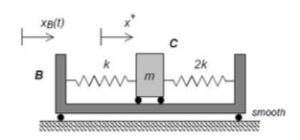| Problem statement Solution video |
DISCUSSION THREAD

Low frequency: ω < ωn
As expected, the response is in-phase with the base motion. Can you see this?

High frequency: ω > ωn
As expected, the response is 180° out-of-phase with the base motion. Can you see this?

Any questions?? Please ask/answer questions regarding this homework problem through the "Leave a Comment" link above.
Is excitation frequency something that exists when only an outside force is applied? Or is it some kind of intrinsic property of a system like natural frequency?
The excitation frequency is the frequency at which a body is made vibrate in forced vibration, which occurs when an outside force is periodically applied to the system. So, I believe it is not an intrinsic property but dependent on the external forces in the individual problem.
When completing this question, keep in mind that the normal forces acting on the wheels are equal and opposite from the perspective of the center of the cart.
This problem is very similar to Example 6.C.5, which was solved in class today. It is important to first solve for the standard form of your EOM, and then proceed to find the particular solutions. Remember that the undetermined coefficients can be solved by separating the sine and cosine components.
To solve this problem start by drawing a FBD of the block. Sum up the forces in the x direction to solve for the natural frequency using the EOM. Calculate the double time derivative, and then plug that into the EOM to solve for the coefficients A and B.
Remember when solving that the particular solution (xp(t)) is only in terms of A and the sin(wt) because B = 0 and the system is undamped.
When drawing the free-body diagram, I found it very helpful to picture what happens if x_b is greater than x by drawing the new system. If the larger frame moves further to the right than the box does, the right spring will be elongated and left spring will be compressed. The forces can then be drawn accordingly.
I found it useful to set the EOM with the spring force from the base set as k(x-x_b) to take the motion into account.
Remember to take into consideration the direction of the spring force depending on if you use k(x-xb) or k(xb-x).
When solving this problem, it is helpful to solve for the natural frequency by summing the forces in the x-direction and using the EOM. Using the EOM can be done by finding the first and second derivatives to solve for A and B.
I found that using Example 6.C.5 helped me understand the process of how to solve this. I also found the step of creating the FBD to be vital to solving the problem, I found it useful to assume that x_b was larger than x.
As you work through this question, remember that the normal forces acting on the wheels are equal and opposite relative to the cart's center point.
When solving this problem, make sure to draw the arrows in the Free Body Diagram in the correct direction based on if xb - x or x - xb is used.
The setup of this problem is similar to example 6.C.5 and the main thing to keep in mind is to make sure the signs are consistent. You don't have to be correct in the guess of which way the block would move as long as you are consistent with the direction.
It is significant to understand that the plot of the excitation frequency will have a change at the natural frequency. The plot changes from an increasing trend to decreasing after that point.
make sure to note the +x direction and keep track of the spring force's directions so your signs are correct.
Is it possible to solve this question using either k(x-xb) or
k(xb-x)?
Yes, either k*(x-xB) or k*(xB-x) works.
• For k*(x-xB), the two spring forces act to the LEFT on the block.
• For k*(xB-x), the two spring forces act to the RIGHT on the block.
When making a plot of the amplitude versus the excitation frequency, be sure to solve for when the natural frequency occurs, as the direction of the plot will change.
For this question remember the extension of both springs is affected by Xb
And also be careful on the direction of the forces. The signs are crucial here
This problem is best solved by first creating a free body diagram, creating a EOM based on these forces and relative to x, and then solving for the A and B components for x(t) for the particular solutions.
For this problem, it is important to decide which direction the spring forces are acting in and maintain this consistently throughout the problem. You will need to then determine if (xb-x) or (x-xb) is the correct extension and keep this consistent through the problem as well.